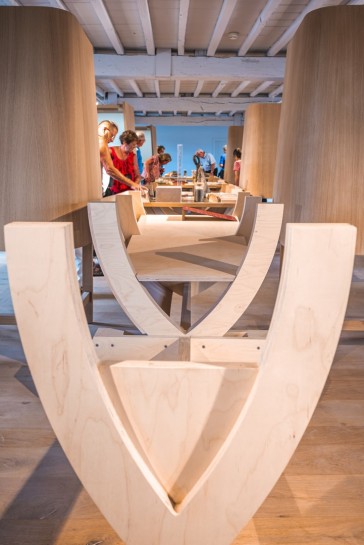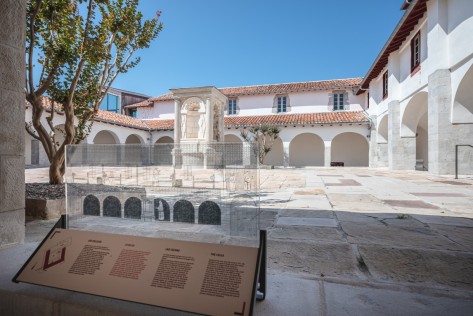What is a CIAP?
A Centre for the Interpretation of Architecture and Heritage (CIAP) is a local cultural organisation which aims to raise awareness, to inform and to train all types of publics regarding the architecture and the heritage of a territory, this territory belonging to the network of Villes et Pays d’Art et d’Histoire (Towns and Lands of Art and History, created by the French Ministry of Culture).
Unlike a museum, a CIAP does not have collections of objects. The learning about heritage takes place thanks to interpretation tools:
- Interactive games
- Mapping
- Films
- Soundtracks
- Manipulable models
- Materials library


These tools are dotted on the exhibition pathway and help visitors understand the history of the heritage and of the architecture of the territory.
The CIAP is accessible to all and is a special place for the transmission of knowledge, its tools being necessary to understand the town, to orient oneself in it and to go on discovering other cultural places in the territory.
The Villes et Pays d’Art et d’Histoire (Towns and Lands of Art and History) label
What is it?
Since its creation in 1985, the Villes et Pays d’Art et d’Histoire (Towns and Lands of Art and History) label has been awarded by the French Ministry of Culture to towns and lands which choose to commit to proactive actions for public awareness-raising, public culture coordination and conservation with respect to the quality of heritage and architecture.
To date, the national network includes 190 Towns and Lands of Art and History, of which there are 120 towns and 94 lands.
 The Nouvelle-Aquitaine region is one of the French regions with the most of these Towns and Lands of Art and History, 28 territories having received the label. In the department of Pyrénées-Atlantiques, there are two Towns of Art and History (Bayonne and Pau) and two Lands of Art and History (the Pyrenees of the Béarn area, and Saint-Jean-de-Luz and Ciboure).
The Nouvelle-Aquitaine region is one of the French regions with the most of these Towns and Lands of Art and History, 28 territories having received the label. In the department of Pyrénées-Atlantiques, there are two Towns of Art and History (Bayonne and Pau) and two Lands of Art and History (the Pyrenees of the Béarn area, and Saint-Jean-de-Luz and Ciboure).
To find out more on the Towns and Lands of Art and History label and its missions towards different publics, see the 4 video capsules on the missions of the Towns and Lands of Art and History scheme:
Our territory has received the Pays d’Art et d’Histoire (Land of Art and History) label
In 2016, the towns of Saint-Jean-de-Luz and of Ciboure joined together through the Association of Municipalities of the bay of Saint-Jean-de-Luz and Ciboure, and obtained the label Land of Art and History. This success followed on from substantial work for the inventory and promotion of the heritage and architecture carried out by the two towns and allowed the realization of an extensive heritage project for the territory.
In the context of the application to the label, a video presenting the bay was made, which highlighted the specific identity of the territory of Saint-Jean-de-Luz and Ciboure:

The territory includes two Remarkable Heritage Sites (Sites Patrimoniaux Remarquables, designated by the French Ministry of Culture) and several historical monuments, and its cultural richness is promoted by the Land of Art and History team, which offers an annual schedule of visits, meetings, exhibitions, conferences, etc.
Actions of the Land of Art and History label
The actions of the Land of Art and History label promote the heritage and architectural quality of the bay and focus on four areas:
- The CIAP Les Récollets: this organisation aims to coordinate cultural access to heritage and invites various types of publics to get a better understanding of the history of the bay of Saint-Jean-de-Luz and Ciboure.
- The Rendez-vous (pdf - 3Mo): an annual schedule of cultural events on architecture and heritage (visits, meetings, workshops, artistic exhibition pathways, national days, exhibitions, conferences, etc.)..
- The explorateurs (pdf - 2Mo): educational activities for schoolchildren of all ages.
- The Parcours: publications and games to discover the heritage of the bay independently.
The CIAP Les Récollets team
- Director
Amandine Guindet - Head of the administrative and financial hub
Chantal Etchebaster - Cultural Coordinator for the general public
Myriam Touati - Cultural Coordinator for Young People
Maider Mourguiart - Technical Manager
Christian Larralde - Reception Manager
Camille Manon




